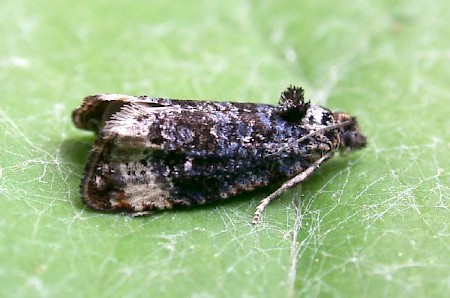49.186 BF1097
Endothenia gentianaeana
(Hübner, [1799])
Wingspan 15-19 mm.
This is one of several species of Endothenia in which the adults closely resemble each other, and require dissection of the genitalia for accurate identification. Adults fly in June and July, usually in the vicinity of teasel (Dipsacus fullonum).
In England and Wales, it is commonest in the south and scarcer northwards, but it can be locally abundant in northern England if teasel is plentiful and permanently established; at some localities occupying 100% of the teasel seedheads.
The larva always feeds singly on the pith in the cavity of a teasel seedhead. It can be distinguished by the lack of an anal comb from the larva of E. marginana, which has an anal comb and is often found in teasel seedhead cavities. (See larval descriptions and photographs).
Larva (Description I.F. Smith)
Foodplant: September to May in pith of seedhead of Dipsacus fullonum.
Early instars
Length: Approximately 10 mm to 15 mm.
Head: Brown ochre. Frons and posterior edge of capsule thinly lined black. Mouthparts reddish brown. Black postero-lateral mark. Stemmata colourless enclosing black stemmatal area.
Prothoracic shield: Blackish grey. Divided by medial line concolorous with body. Small greenish white spot at base of setae.
Thoracic legs: Yellowish brown, translucent.
Body: Pale greenish white, translucent, slightly shagreened.
Spiracles: Brown peritreme.
Pinacula: Slightly greyer than integument.
Setae: Colourless transparent. Some brownish towards posterior of abdomen.
Anal segment: No anal comb. Anal plate translucent yellowish green with some grey spots on anterior.
Prolegs: Concolorous with body. Anal prolegs rotundly swollen. Crochets reddish brown.
Late instars
Length: Approximately 15 mm to 17 mm.
Head: 17 mm; dark pitchy brown, almost black. 15 mm; capsule dark reddish brown (venetian red) overlaid with very dark brown (vandyke brown) laterally and dorsally. Frons and posterior edge of capsule thinly lined black. Mouthparts reddish brown. Black postero-lateral mark. Stemmata colourless enclosing black stemmatal area.
Prothorax (T1): Wide transparent anterior margin. Prothoracic shield pitchy brown divided by medial line, concolorous with body. Small spot at base of setae, concolorous with body.
Thoracic legs: Golden brown.
Body: Translucent, slightly shagreened, greyish white. Contractile dorsal vessel shows as indistinct darker dorsal line.
Spiracles: Brown peritreme.
Pinacula: Shiny, slightly greyer than integument. On segment A9 the large pinacula are similar in colour to the anal plate.
Setae: Colourless transparent. Some brownish towards posterior of abdomen.
Anal segment: No anal comb. Anal plate translucent brown with darker (vandyke brown) spots on anterior. (The change from yellowish green, through yellowish brown, to brown occurs at variable lengths.)
Prolegs: Concolorous with body. Anal prolegs rotundly inflated. Crochets brown.
Similar species: The diagnostic features which differentiate E. gentianaeana from E. marginana, which also occurs in the pith of Dipsacus fullonum, are highlighted in the description above. Caution should be used with head colour, as later instars of E. gentianaeana can have very dark pitchy heads that can be mistaken for black, and E. marginana can have a pitchiness on the head that makes it indistinguishable from the darkest E. gentianaeana. The most reliable feature is the anal comb on E. marginana, which is absent on E. gentianaeana.
Occasionally the larva of Blastobasis decolorella is found feeding in the seedhead pith of Dipsacus fullonum. Like E. gentianaeana, it lacks an anal comb, but its head and prothoracic plate are much lighter brown than on either species of Endothenia, and its pinacula are arranged differently.
Examination hints: Anal combs, even when present, are often not visible when larvae are viewed from directly above. The larva should be tilted on a small watch glass, or similar, and its posterior viewed end on with a binocular microscope or a X10 lens. The anal flap, which bears the comb of E. marginana, can sometimes be withdrawn under the anal plate (see middle image of anal plates of E. gentianaeana ) and conceal the comb for a time, so do not hurry the examination.
Search hints: Peel back a strip of a teaselhead, starting at the top, aided by a penknife. If the pith is discoloured or chewed, or if any frass can be seen, there is likely to be a larva. After examination the larva can be replaced and the seed head bound shut with several twists of cotton thread. Keep outside in netting until April, when it can be brought indoors and watched for emergence.

 UKMoths
UKMoths 








